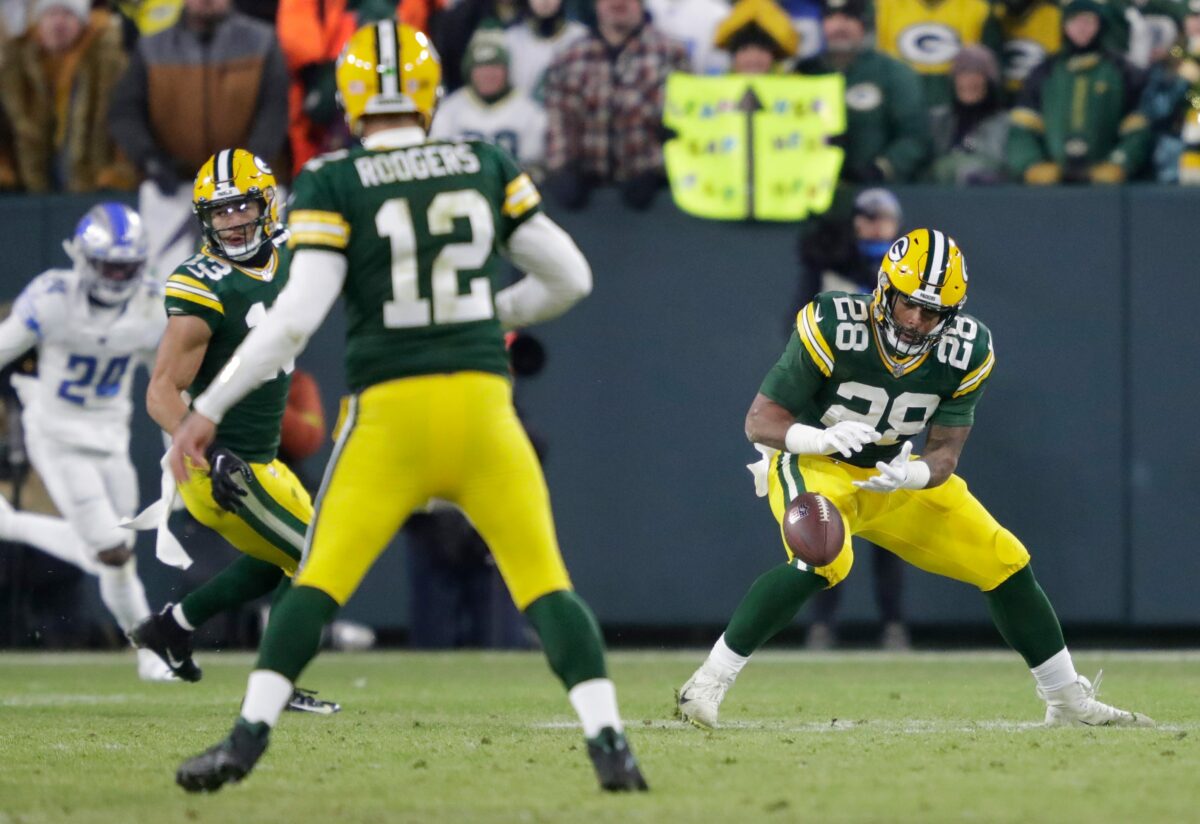[anyclip pubname=”2103″ widgetname=”0016M00002U0B1kQAF_M8036″]
The Green Bay Packers need running back A.J. Dillon to rebound from a somewhat disappointing third season in 2022 and regain the all-around efficiency that made him one of the NFL’s most valuable No. 2 backs and could secure his future in Green Bay long-term.
During his first two seasons, Dillon averaged 4.5 yards per carry and caught 92.3 percent of his targets. Last season, Dillon’s average per carry dropped to 4.1 and he caught only 65.3 percent of his targets, resulting in him gaining almost 150 fewer yards in 2022 despite receiving nearly the same amount of touches in 2023.
Dillon, a second-round pick in 2020, is entering a contract year. He’ll need to prove to the Packers he’s worth a second contract, which likely means proving he can eventually take over as a lead running back and not just a sidekick to Aaron Jones.
In 2022, Dillon was a far less effective runner on first down (4.8-yard average in 2021, 4.0-yard average in 2022) and when the Packers were under center (4.6-yard average in 2021, 3.7-yard average in 2022). According to PFF, he broke eight fewer tackles in the run game in 2022 and averaged fewer yards after contact, although he was still around the 3.0-yard average after contact. Amazingly, Dillon averaged over 4.0 yards per game in just eight of the 17 games he played in 2022.
His value in the passing game plummetted. In 2021, Dillon caught 34 of 37 targets while averaging 8.6 yards per target, all incredible numbers for a running back. Last season, he caught 28 of 43 targets and averaged 4.8 yards per target, both among the worst marks for a running back. Drops were an issue; Dillon dropped five targets, per PFF. He finished the season with only four games of producing 20 or more receiving yards despite going out into routes on over 250 snaps.
It all amounts to a player taking a small step back after a true breakout second season. This is a relatively common phenomenon. A young player takes a big developmental step in Year 2 but at the same gains respect from opponents and forces an opponent to change the way he’s defended, and Year 3 ends up not being as productive.
Maybe Dillon can follow in the footsteps of Dorsey Levens, another big back who had some up and downs moments as a complementary player alongside Edgar Bennett before breaking out as a legitimate No. 1 during his fourth NFL season. Dillon probably won’t get he same opportunity in 2023 as Levens got in 1997 barring an injury to Aaron Jones, but it wouldn’t be surprising if Dillon came close to 250 total touches as the Packers transition away from Aaron Rodgers and lean more on Jones and Dillon in 2023.
There was still plenty to like about Dillon’s 2022 season: He produced more runs of 10 or more yards than in 2021 and finished fifth among all running backs in Football Outsiders’ Success Rate, suggesting he was better at creating big plays and still a consistently successful runner based on situation. He was also fifth in PFF’s Rushing Grade and 11th in Football Outsiders’ DVOA.
Now, Dillon has a chance to build on what he’s done during his first three seasons and show the Packers he’s ready for more, including a second deal. Jones’ future beyond 2023 is a little murky, although his new deal is structured to keep him in Green Bay through 2024. If Dillon emerges this year, however, the Packers may see him as the top option for 2024.
The 2020 draft was one of building the future. Entering 2023, Jordan Love is taking over at quarterback, Josiah Deguara will play more snaps at tight end/fullback and Dillon has a chance to be a difference-maker at running back. All three are under pressure to prove they are part of the long-term plan in Green Bay.
